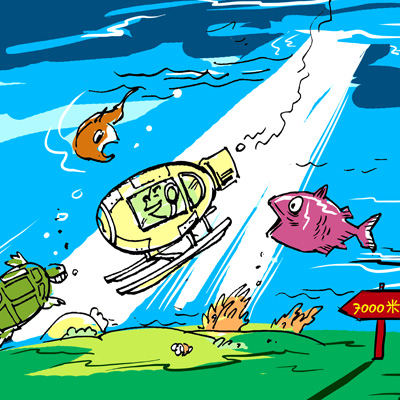|
 |
|
(CFP) |
"The South China Sea is like a living organism," Wang said. "The rock structure is his bone; sediments of various sea life and sand form his flesh; ocean currents act as the blood."
In 1997, a proposal titled the Historic Record of East Asia Monson in the South China Sea and Its Global Influence submitted by Wang and his colleagues won first place in the ODP organization. The proposal led to the first oceanic drilling project in Chinese territorial waters in the spring of 1999, for which Wang was a chief scientist.
During that voyage, Wang and his team drilled 17 holes at six deep-sea locations and obtained a total 5,500 meters of rock core. After several years of analysis, Wang and his colleagues established a database of the environment and earth layer profile of the West Pacific Ocean with a time span of 32 million years, providing full and accurate materials for scientists to study the environmental change of the area.
After years of efforts, Wang and his wife, Sun Xiangjun, a research fellow of the Institute of Botany at the CAS, finally proved the origin of East Asian seasonal wind: It was caused by the inversion of ancient geography about 25 million years ago. According to their joint study, China used to be higher in the east and lower in the west, which was exactly opposite of today's topography. The seasonal wind occurred when the physical features of China shifted.
Wang received the Milutin Milankovic Medal by European Geosciences Union in 2007 for his outstanding research in climatic changes.
Wang's contributions to ocean science have also been praised by foreign scientists who collaborated with him. "Wang was one of the first to put monsoons in a global context. That was extremely original and insightful," said Carlo Laj, a well-known French oceanic scientist. They worked in cooperation on a paleoceanographic study of the South China Sea.
Diving into the blue
In addition to climate and geological discoveries, Wang made other important findings during his study of the deep sea.
Wang found natural gas hydrate reserves in the South China Sea, for instance. "The ice-shaped natural gas under the seabed can be used as clean energy," Wang said. When the ice is lit and melts, it releases methane, which is a clean natural energy.
According to a preliminary calculation, there are much more natural gas hydrate reserves than oil reserves on the Earth. Thus, the new energy resource could have huge potential in the future.
Most people believe that life cannot exist without sunlight. However, Wang's study may change this viewpoint. "There is no sunlight below the depth of 600 meters under water. But people have discovered thousands of creatures below that depth. This unexpected discovery reveals the power of nature," Wang said. "For the biosphere in the dark water world, life depends on terrestrial heat rather than sunlight."
Few realize that the bottom of the sea has its own bio-system, Wang said. The underground water below the seabed can transfer many materials such as carbon, which is a key part of all lives on the Earth.
Wang is busy training young scientists and improving the level of research into the ocean. What keeps him going is the positive change of working conditions today.
China has devoted more attention to oceanic science in recent years. In particular, the National Natural Science Foundation of China launched the largest comprehensive deep-sea research project of the South China Sea in 2011. Wang has been designated as chief scientist in the undertaking. It will take eight years and 150 million yuan ($23.6 million) to conduct a thorough investigation in the South China Sea. Chinese scientists expect to discover the origins of the South China Sea, the interactive mechanism between the deep sea and bio-systems, and the area's evolutionary history.
Who is Wang Pinxian?
Date of birth: November 14, 1936
1960-72: teacher, Department of Geology, Department of Geography, East China Normal University
1972-81: assistant, then associate professor, School of Ocean and Earth Sciences, Tongji University
1982-present: Professor, School of Ocean and Earth Sciences, Tongji University
1991-present: Academician, the Chinese Academy of Sciences
Published books: Marine Micropaleontology of China, Major Pleistocene Stages in Carbon Perspective: The South China Sea Record and Its Global Comparison
Email us at: tangyuankai@bjreview.com | 